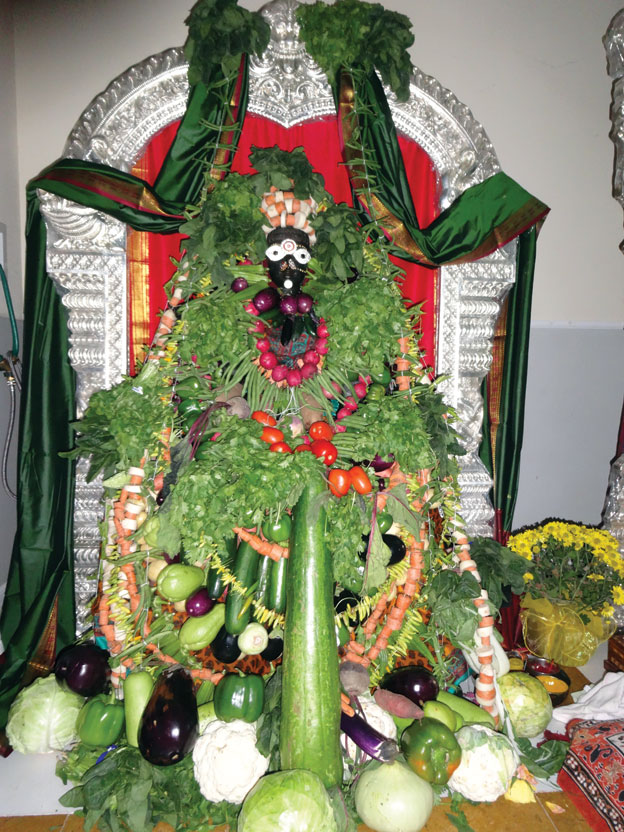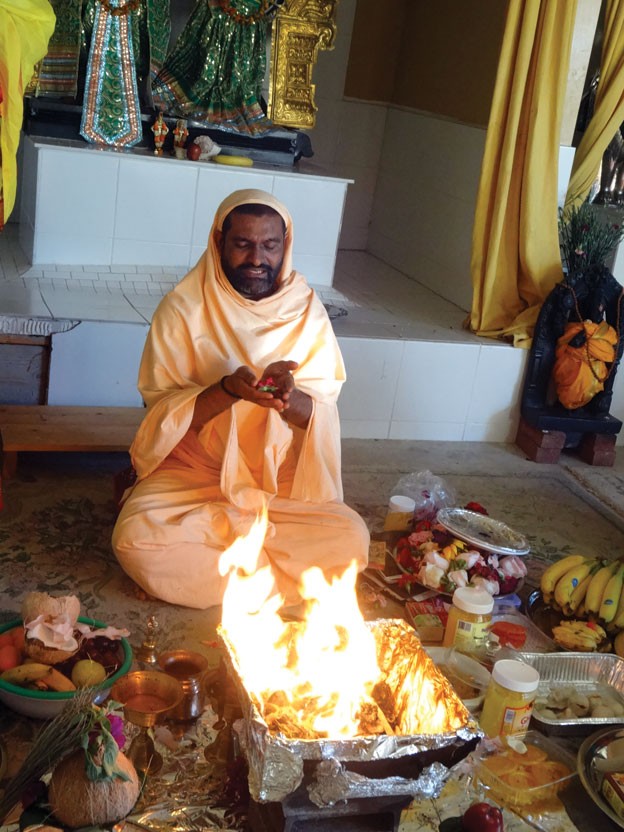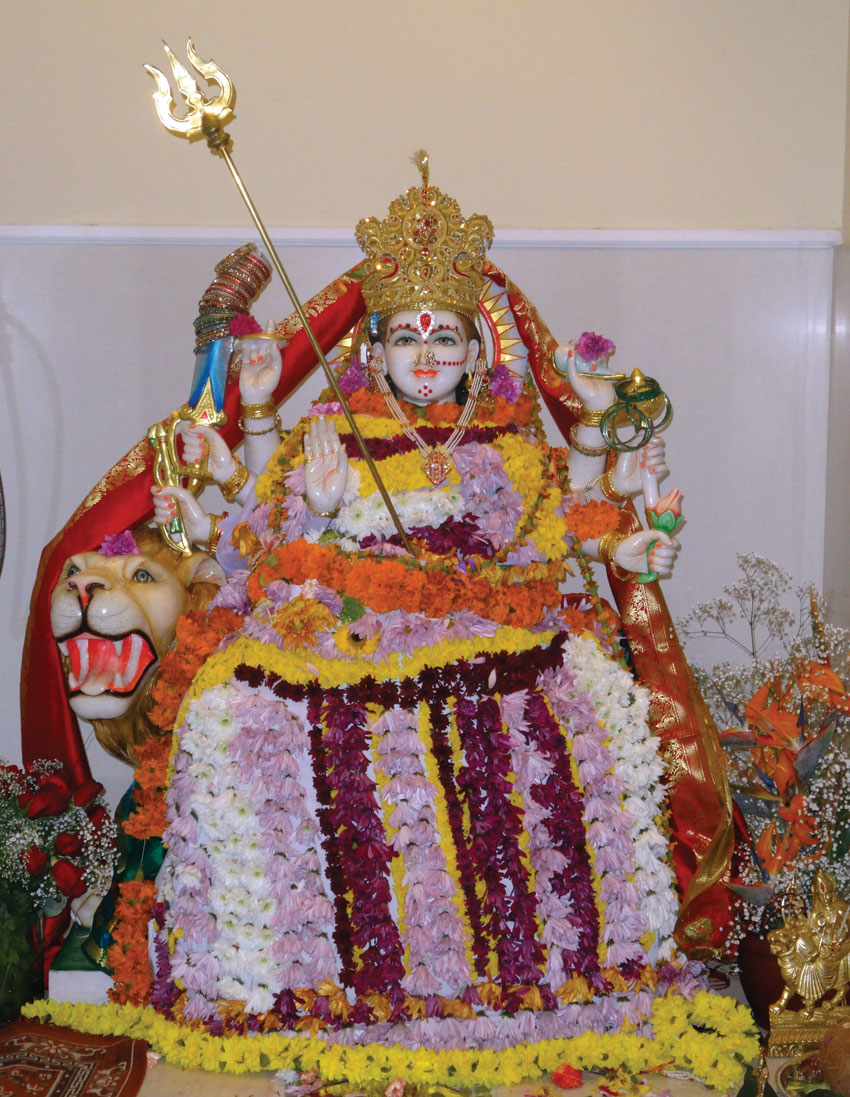Navaratri Marked
Pushpa Alankar Sri Durga Devi.
[divider type=”thin”]
The Balaji Temple in San Jose, Calif., celebrated Navaratri with usual pomp and fervor. Kids and adults pitched in to mark this celebration of good overcoming evil. Vijayalakshmi presents a report.
[divider type=”thin”]
The Navaratri celebrations at Balaji Temple were held with usual pomp and fervor. This festival falls during the Hindu calendar month of Aswayuja Suddha, generally in the months of September or October. This year the festival started on Sep. 23 and ended on Oct. 3, and was attended by large number of devotees. Navaratri represents a celebration of the Goddess Amba, (the Power).
The event started with Kalasha puja and Kalasha sthapana and keeping of Golu.
On each day in the morning Swami Narayananda Puri performed Chandi Homa. In the evening there were cultural programs. During the first three days, Devi was worshipped as Sri Durga or Kali, the destroyer of all evils and granter of boons. The next three days are devoted to Sri Lakshmi, the goddess of wealth. The final three days, prayers were offered to Sri Saraswati, the goddess of wisdom.
On all nine days, the deities were beautifully dressed with different alankarams. Goddess Mahalakshmi Abishekam was done on Sep. 26 and shakambari alankaram was done on Panchami for goddess Mahalakshmi. Godessess Durga was dressed with flowers (poolangi) on Durga Ashtami. Goddess Vasavi Matha was dressed beautifully with silver kavacham after abishekam.
On the tenth day, Vijaya Dashmi was celebrated with Sumangali Pooja and satsang by Swamiji where he gave a discourse on Lalitha Sahasranama sloka.
“Nava-ratri” literally means nine nights. This festival is observed twice a year, once in the beginning of summer and again at the onset of winter.

(Above): Shakamabhari Alankar of Mahalakshmi.
Navaratri is divided into sets of three days to adore different aspects of the supreme goddess. On the first three days, the Mother is invoked as powerful force called Durga in order to destroy all our impurities, vices and defects. The next three days, the Mother is adored as a giver of spiritual wealth, Lakshmi, who is considered to have the power of bestowing on her devotees the inexhaustible wealth. The final set of three days is spent in worshipping the Mother as the goddess of wisdom, Saraswati. In order have all round success in life, we need the blessings of all three aspects of the divine mother; hence, the worship for nine nights.
In North India, as the culmination of Ramlila which is enacted ceremoniously during Dussehra, the effigies of Ravana, Kumbhakarna, and Meghanada are burnt to celebrate the victory of good (Rama) over evil forces on the Vijaya Dashmi day.
Navratri is celebrated in many Indian communities. The mother goddess is said to appear in nine forms, and each one is worshiped for a day. These nine forms signify various traits that the goddess influences us with. The Devi Mahatmya and other texts invoking the Goddess who vanquished demons are cited.
During the eight or ninth day, Kanya Puja, pre-pubescent girls are ceremonially worshipped. It is a custom to wash the feet of these nine young girls as a mark of respect for the Goddess and then offer new clothes as gifts by the devotee. Kanya puja as a part of Devi worship is to recognize the feminine power vested in the girl child and to give them as much importance in the social. Saraswati Puja is performed on the 9th day. Ayudha Puja is conducted in many parts of South India on the Mahanavami (Ninth) day with much fanfare. Weapons, agricultural implements, all kinds of tools, equipments, machinery and automobiles are decorated and worshipped on this day along with the worship of Goddess. The work starts afresh from the next day, i.e. the 10th day which is celebrated as Vijaya Dashmi.

(Above): Swami Narayananda offering prayers.
Many Bay Area music schools participated in the cultural program. The festival ended in the night by burning the effigies of Ravana and Kumbakarna to symbolize the victory of good over evil. Legend has it that on this day the Devi destroyed the all powerful Mahisasura, the man with a buffalo head, signifying the triumph of good over evil.
The Sharad Navratri is considered as a very auspicious time for starting new a job, ventures, or entering new homes and marriage.


